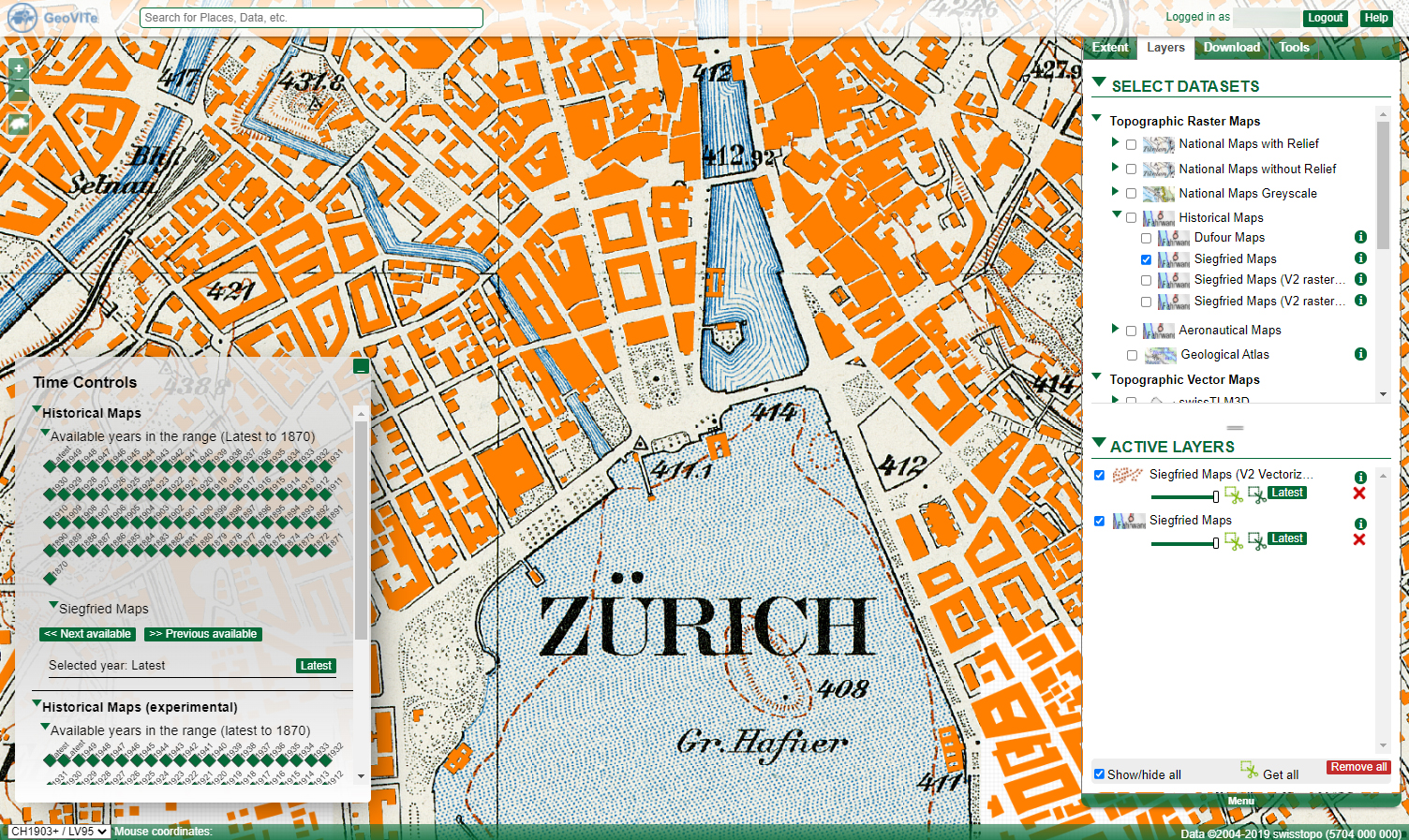Image: Vectorized buildings (orange) from the first edition of the Siegfried Map with the corresponding raster map in the background (source: GeoVITe).
The GeoVITe platform provides topographic raster and vector maps, digital elevation models and orthophotos for research. Roman Walt, who supports and advises the users of the platform, explains in an interview how the data from GeoVITe can be used, what the added value is compared to the data from Swisstopo – and he reveals the funniest request.
GIS Hub: Roman, you are originally a sociologist and historian, how did you get into maps and geodata?
Roman Walt: It wasn’t planned that way from the start (smiles). During my studies in history, I had to deal with old holdings, for example, the Zurlaubiana collection of the Aargauer Kantonsbibliothek (Aargau Cantonal Library). The holdings include militaria from the 17th and 18th centuries, i.e. works on military history or training regulations for mercenary troops. When a position became available at the ETH Library as a student assistant for old prints, I applied for it – and got it. Since then I haven’t been able to get away from the ETH Library (laughs). After graduation, I got a permanent position and in 2015 I switched to the maps. I had the necessary computer science experience because I had already programmed as a teenager. Later, I completed further training in geoinformatics and today I work in the field of GIS and electronic maps.
Among other things, you now manage the GeoVITe platform, which provides topographic raster and vector maps, digital elevation models and orthoimages for universities. How did the platform come about?
Around the year 2000, geospatial data existed, but without prior knowledge, it was difficult to look at and work with it. Ionut Iosifescu-Enescu and his wife Cristina from the Institute of Cartography and Geoinformation at the ETH (IKG) wanted to change this circumstance so that researchers needed less time for data visualization and acquisition and had more time for their projects. Their idea was and still is, by the way, to visualize and procure geodata quickly and easily via a browser or webapp. This is how the first prototype of GeoVITe was born. Later, the ETH Library joined as a partner and the platform was further developed.
What can I do with the data from GeoVITe?
Everything (laughs). No, seriously, the uses are very diverse. I can use the geospatial data for a simple background map for a poster or a presentation, be it an aerial photo or a national map. Or I can download one or more datasets for an area I define in one click, for example a hydrological dataset and a road dataset. But I can also analyze long time series to find out how Zurich has developed since the 1950s, what has happened in terms of spatial planning in the Swiss Plateau, how land use has changed, and so on.
GeoVITe-Workshop: Benefits and opportunities of geodata
March 14, 2023, 12.15-13.45 Uhr
The GeoVITe platform makes geodata available to all UZH researchers and students*. This includes topographic raster and vector maps, digital elevation models and orthophotos of Switzerland. At the workshop, we will show you how to download the geodata from GeoVITe and use it for your project. In addition, you will learn what the difference is to the data from Swisstopo. A few practical examples round off the workshop.
Register here!
GeoVITe’s data strongly resemble Swisstopo’s offering. What can GeoVITe do that Swisstopo cannot?
One advantage of GeoVITe over Swisstopo is related to the example just mentioned of the two data sets that can be downloaded in one step. With Swisstopo, I have to download each dataset separately, selecting my area over and over again. In addition, with GeoVITe I can freely select my area, while with Swisstopo I have to download all tiles that are in my desired area each time or cut it, i.e. I always download a bit more data than I need and cut the area later in a GIS program. Thus, using GeoVITe is easier, faster, and less error-prone.
There are other advantages as well: GeoVITe offers time series of geodata. For example, I can download the national map from different years, while Swisstopo usually only provides the most recent data. Especially if I want to investigate time series, these data from the past are very valuable. Moreover, they are also important for the traceability of the research.
Finally, we also offer cantonal data as well as data that we have processed further. The IKG vectorizes data from old national maps, e.g. buildings, which can be used for object recognition.
Do you find out how the data is used?
In the past, when the data was not open and it required a publication record, we often received specimen copies. Today, we are occasionally sent a link to an article or poster in which data from GeoVITe has been used. Through inquiries, we sometimes learn what is planned when someone needs a special format.
What was the most unusual project that was realized from the GeoVITe data?
The funniest request came from someone who wanted to decorate the tiles in a toilet with the national map. That was when data use was not yet open, and brought exciting clarifications with it. Unfortunately, I never saw the final result (laughs).
What are your challenges in terms of digital maps and geodata?
We would like to direct the platform more towards large data volumes. If I want to download data for the entire canton of Zurich today, it’s not so easy to do so via the platform because the infrastructure is not powerful enough. Newer data products with extremely high resolution are unfortunately not yet accessible via GeoVITe. But you can request this data from us at any time and we will find a way to provide you with it, that’s no problem.
Swisstopo is making more and more data available to the public free of charge. Will your services become obsolete at some point?
If Swisstopo or another (government) actor offers exactly what we currently do, then yes. At the moment, however, our services do not coincide, because our target group and our purpose are different. Swisstopo provides data for the public, we for research at universities. This is also supported by our usage figures, which have remained stable over the years, even though Swisstopo has been making digital geodata available free of charge since March 2021.
What are GeoVITe’s plans for the future?
As mentioned, we would like to make the infrastructure more powerful. Further, we would like to offer more data formats because more and more disciplines are doing research with geospatial data, but working with different formats than we offer so far. One example is the architecture that uses CAD or Drawing Exchange Format (DXF). We already convert to other formats today, but manually and on demand. The goal is to offer additional formats such as COG (cloud optimized geotiff), EXIF (a jpg with geo-information) or DXF as standard through the GeoVITe platform and thus reach more researchers.
GeoVITe stands for Geodata Visualization and Interactive Training Environment. The name reflects the original idea of building a platform through which geodata can be visualized and downloaded. In the early days of the platform around the year 2000, it was not possible to display geodata without additional software. The platform helped the users at that time to handle and practice with geodata, which explains the second part of the name.
Later, the focus turned away from training towards usage and data provision. Subsequently, the portal was renamed “Geodata Versatile Information Transfer Environment”, while the acronym remained GeoVITe.
Today, GeoVITe offers a variety of topographic raster and vector maps, digital elevation models, and orthoimages. The platform is accessible free of charge via the Switch edu-ID.
Roman Walt has been a member of the maps and geodata staff at the ETH Library since 2015. In this role, he manages the GeoVITe platform, provides training and advises users on how to use the data. Roman also ensures that new data sets are added to the platform. To do so, he sets up crowd-sourcing projects, i.e., in which volunteers georeference old maps. Originally, Roman studied sociology and history and already worked for ETH as a student, first at the Economic Research Center and later at the library. After graduation, he completed a complementary graduate degree in Geoinformatics and a MAS in Library and Information Science.

